Last updated May 2025 | Words and photos by Vietnam Coracle | 6 comments

Tom Divers is the founder and creator of Vietnam Coracle. He’s lived, travelled and worked in Vietnam since 2005. Born in London, he travelled from an early age, visiting over 40 countries (he first visited Vietnam in 1999). Now, whenever he has the opportunity to make a trip, he rarely looks beyond Vietnam’s borders and his trusty motorbike, Stavros. Read more about Tom on the About Page, Vietnam Times and ASE Podcast.
The temples of the forest, banyan trees are great, natural edifices rich in cultural, spiritual and folkloric symbolism as well as practical usages. A bridge between the human, natural and spirit worlds, banyan trees are living altars and a link between the past, present and future. Growing to enormous sizes and living for many centuries, banyans connect generations and are a symbol of life, longevity, stability, growth and vitality. The mesmerizing scale and complexity of their organic architecture has made banyans the tree of poets and wanderers; a refuge for travellers and rebels; a place of worship and deities. In Vietnam, banyans are found deep in the jungles, far from human habitation. But they also traditionally stood at village gates, in market places, communal houses and places of spiritual gathering, such as shrines and pagodas. Banyans are majestic and beautiful, exotic and heroic, mysterious and magnificent: a sight to behold for any traveller, but particularly those that, like me, hail from temperate regions, where banyans rarely grow. Vietnam is one of several countries where great, ancient banyans are found. To be beneath the splayed branches and giant pillars of a grand old banyan is to feel a certain magic: these trees have an undeniable presence, exuding a noble, timeless and benevolent aura. I’ve tried to capture and understand some of that magic in this Ode to a Banyan Tree.
*For my friend, Thom, who taught me to climb, and to love, trees.
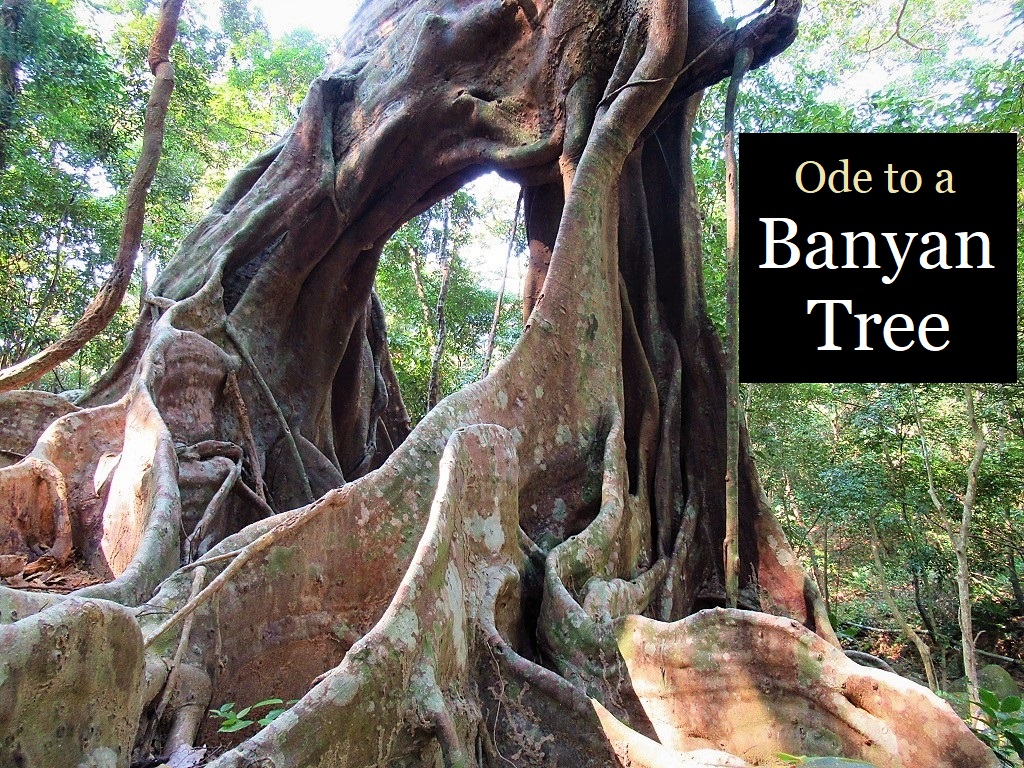
[Back Top]
ODE TO A BANYAN TREE:
Below I’ve written about different aspects of the banyan tree. I describe their physical appearance and natural origins, their cultural symbolism and historical uses, the reasons for their declining numbers and specific examples of great banyan trees in Vietnam. Click an item below to read more:

CONTENTS:
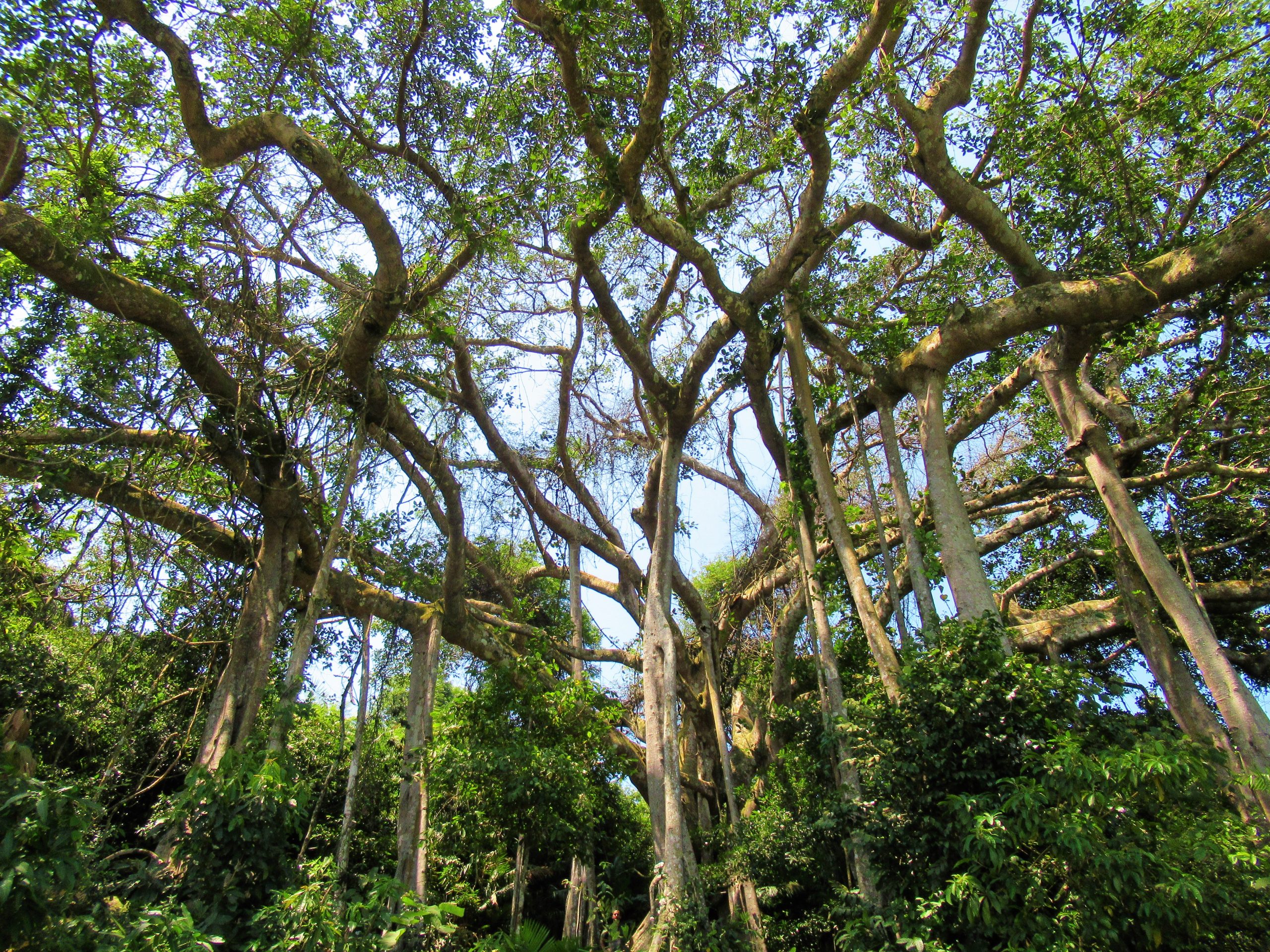

Structure, Appearance & Nature:
Almost extraterrestrial in appearance, banyans wouldn’t look out of place in the forests of the moon Pandora, from James Cameron’s film, Avatar (2009). The organic structure of a banyan tree is complex, intricate and fascinating: roots tangled and curled around boulders, forming arches and valleys on the forest floor; secondary-trunks reaching out like tentacles or melting like wax down the primary trunk, almost as if a liquid form of wood had been poured over the tree, flowing in rivulets down the trunk slowly like lava, until frozen in motion. But, for all its tentacles, roots and vines there’s an attractive symmetry to a big banyan. The tree’s multiple sub-trunks act like structural supports – buttresses and columns for the long, laterally-extending branches – allowing the tree to grow as wide as it is tall without compromising stability. The secondary trunks peg out dozens of lateral branches, creating organic Gaudí-esque vaulted hallways and colonnades beneath its canopy.


A species of ficus (fig), banyans come from the same genus as the sacred bodhi tree, under which Siddhartha Gautama (the Buddha) is said to have gained enlightenment, probably some time in the 6th century BCE. Huge old banyans certainly have gravitas: there’s a grandeur about them; a sense of age and permanence; of slow and steady growth. I recall reading that studies have shown being in close proximity to trees encourages the release of oxytocin – the ‘love’ or ‘bonding’ hormone – in humans, making us feel happy in their presence. Indeed, you can’t fail to notice a certain chemical change occur within in you when sitting beneath an ancient banyan. Presumably, humans have evolved like this to encourage a symbiotic relationship with trees.


And yet, the banyan has a dark side. The genesis of a banyan is very much at odds with its image as a sacred, benevolent tree. The banyan is a parasite: its seed dropped from the air by birds, the banyan takes hold of a host tree and strangles it slowly, wrapping vines around its trunk and branches then sending tentacles down to the forest floor to get nutrients from the soil, sucking the host dry and feeding off its prey until it dies, withers and rots away leaving a hollow core where once the original tree stood. This is why many banyans have impressive empty arches or caves at their base: the void left by the host tree. To me, this is a sinister beginning to the life of one of the world’s greatest and most impressive trees.



But, as the banyan takes life away, so the banyan gives life back. An entire ecosystem forms on and around a banyan tree: epiphytes climb its many trunks; its vines are ladders for insects to its fruit; monkeys, squirrels and birds live in its broad canopy, feasting on its figs; its fallen leaves for ants to eat; its rich soil for fungi to grow; homeopathic remedies from its various parts are made. The banyan is a mother a tree, an ancestor and provider – a god – to all those who live within its stable, unmovable yet elegant and shapely sphere. Over many centuries, a banyan grows into its environment, slowly anchoring itself, spreading over an ever-wider surface area, and locking into place as if it had been there since time began. Think of what old-growth banyans must have witnessed over their long lifetimes: lonely banyans in the midst of large jungles, standing tall as many generations of shorter-spanned trees rise, die, decay and rot into the soil around them; or village banyans where dozens of generations of children have played on its branches, traders sold in the shade beneath its canopy, farmers sheltered from the rain, and people gathered and gossiped about events that have long since passed into insignificance.
*I’m not a botanist nor an expert in dendrology: I can’t vouch for the accuracy of botanical information in this article. This page represents only what I’ve read, heard and feel about banyan trees.


History, Myth, Culture & Uses:
The banyan is a tree of myths, legends and spirits. You don’t need to know anything about banyans to recognize their otherworldly quality when you first see one. Apparently, one of the earliest ‘Europeans’ to have laid eyes on a banyan (or at least to have recorded it) was Alexander the Great when, in the 320s BCE, his army marched as far east as the Indian subcontinent. Imagine Alexander and his well-travelled, multicultural entourage awestruck on the banks of the Indus River, gazing up at their first sight of a great banyan tree. These ‘banyan sightings’ were reported back west in the ancient cities of the Mediterranean, discussed among all the other exotica from Alexander’s great pushes into the ‘wild east’.
A few years ago, my friend Thom, who taught me to climb trees when we were growing up in the UK, came to visit me in Vietnam with his partner, Cami. This was his first time in Asia and in the tropics. We went on a motorbike road trip together in the Central Highlands and came across a huge, solitary banyan near the roadside. All alone and majestic, it was the only tree not to have been felled to make way for coffee cultivation in the area. We stopped. The three of stood under its canopy, explored its roots and vines, took photos and washed in a stream running through its trunk. “That’s an amazing tree”, Thom said. It was the first time he’d ever seen a banyan.



To be under, on or in a great big old banyan is to feel a presence. It’s not difficult to understand how the banyan became sacred to many peoples and cultures. Even today, as you travel through Vietnam you’ll see old banyans with simple altars at the base of their trunks displaying offerings to the tree spirits. Two Vietnamese proverbs illustrate the link between the banyan tree and the spirit world: Cây đa cậy thần, thần cậy cây đa (The banyan tree trusts the gods, the gods trust the banyan tree) – suggesting a connection, via the tree, between earth and ‘heaven’, the natural and the supernatural. Another goes: Thần cây đa, ma cây gạo (The spirits dwell in the banyan tree, the ghosts in the kapok tree) – implying the banyan has a benevolence and is thus habited by spirits, not ghosts.

Because of their size, banyans have been used as shade trees and meeting points in Vietnam, and elsewhere, for thousands of years. Meetings, markets, gatherings and events – some of them historic as we’ll see below – have taken place under their canopy since human civilization began. Indeed, the name ‘banyan’ is said to originate from the Gujarati word for ‘trader’. When the Portuguese came to India they observed how groups of itinerant traders – who traveled from place to place selling their wares – always set up shop in the large pool of shade beneath a particular type of tree, which they called ‘banyan’ or ‘trade tree’. (However, it’s not clear to me whether the name refers to the activity or to the group of traders themselves.) Thus, in times past, the local banyan tree was the equivalent of the ‘central business district’ for many communities. Indeed, travelling around the world, I have occasionally come across local markets that still take place beneath banyan trees today. Despite the tree’s spiritual associations then, its name (in English, at least) is derived from the most human of activities: trade. But, as with the sinister ‘strangler’ origins of the tree itself, the banyan has been used to facilitate less wholesome activities than trade. During the British Raj, the banyan’s long, lateral branches found use as gallows capable of hanging multiple victims simultaneously.
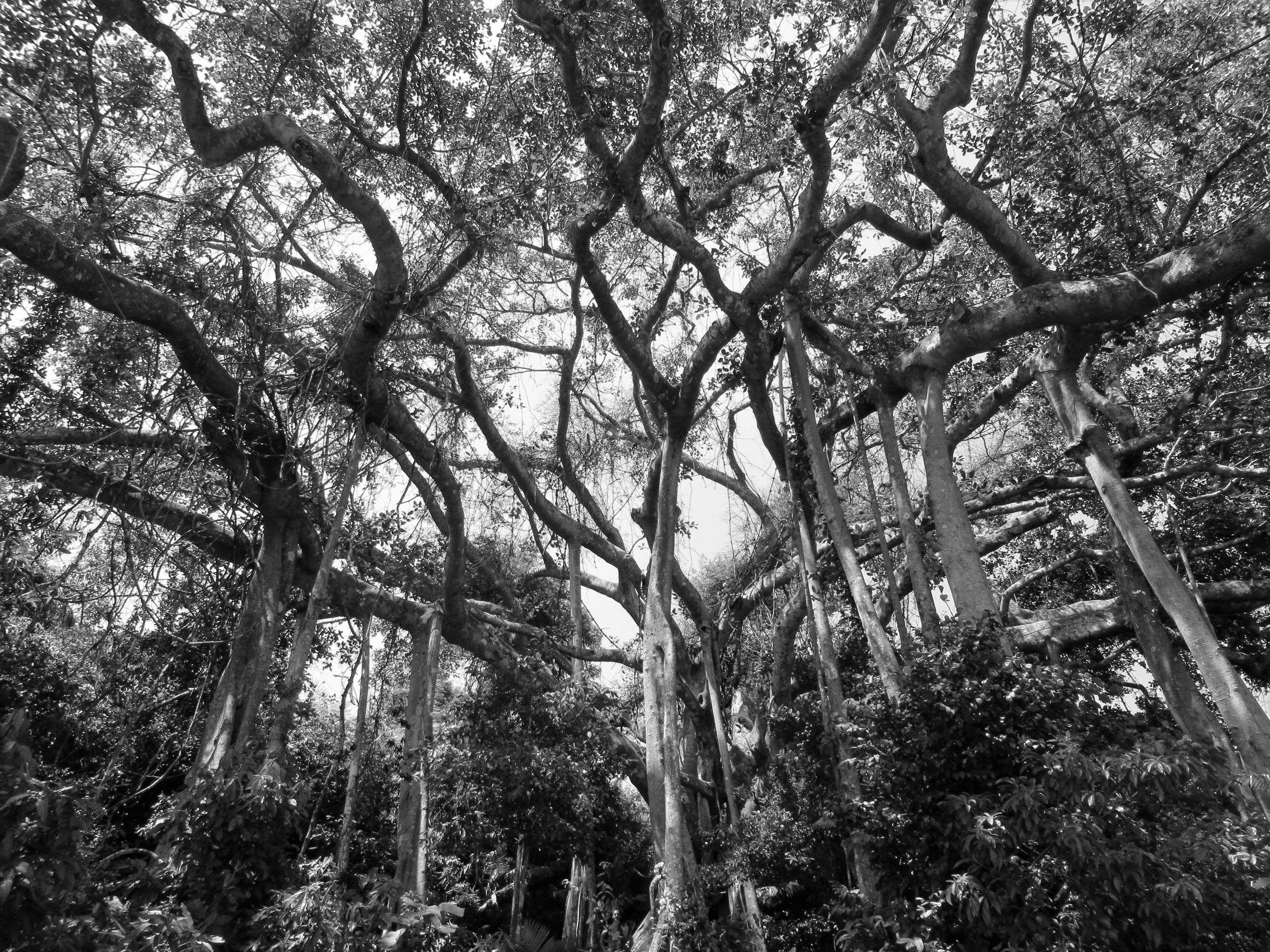

Banyans in Vietnam:
Certain banyan trees in Vietnam are worshiped: either for the tree spirits that are said to dwell within their canopy or for historic events which have taken place beneath their great, splayed branches. In many ways, banyans are to Vietnam what oaks are to Britain: a symbol of strength, age and stability, of natural beauty, awe and majesty, and of folklore, myth and legend. In the past, banyans stood at the entrance to Vietnamese villages – some still do today. Presumably this was part practical (a shade tree), part ceremonial (a village gate), and part religious (a place for spirits to keep watch over the community). But perhaps this tradition has even deeper roots. Perhaps, in some cases, before people began to live in man-made shelters, banyans were themselves proto-villages. This seems relatively plausible on a small scale: banyans cover a wide surface area, offering shelter from the rain, heat and sun beneath their canopy of branches and leaves; safety from certain animals by climbing the ladder of low branches and vines; warmth, protection and security in the ‘cave’ formed by the hollow trunk where the host tree has rotted away; food in the form of figs; tools and utensils fashioned from its wood; medicine from its bark and sap. Banyans are big and could accommodate dozens of ‘inhabitants’. Perhaps, before the earliest man-made hamlets, banyans were hamlets.
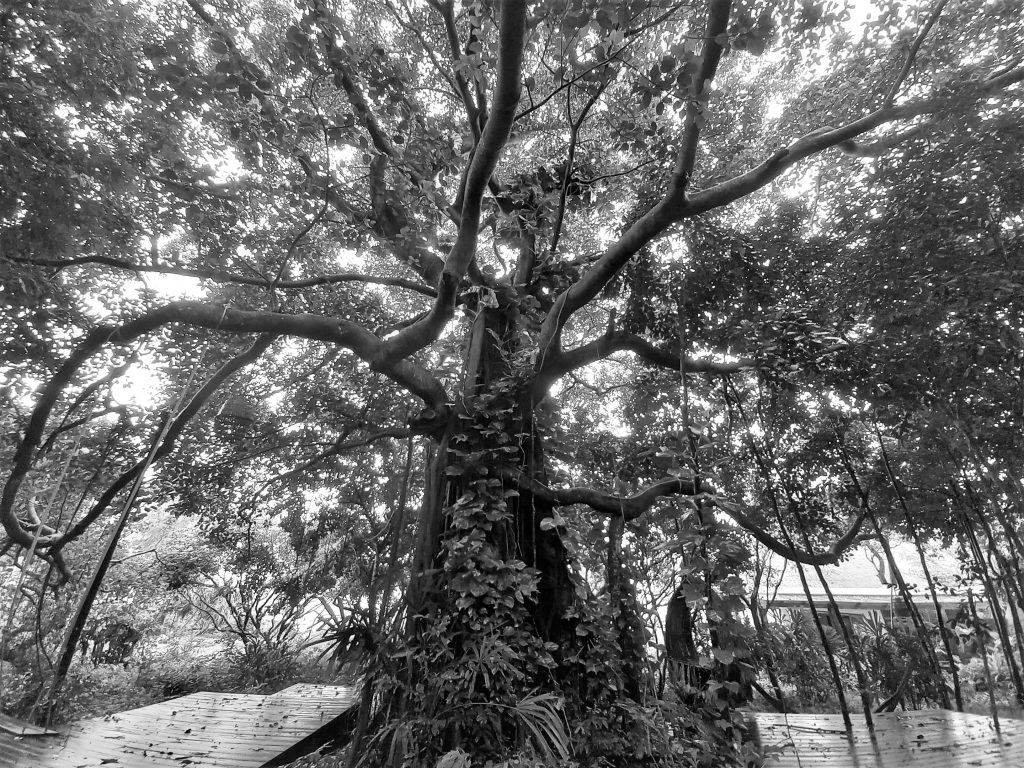

Across the nation there are many celebrated banyan trees; the following are just a few examples. On the tip of Son Tra Peninsula, near Danang, there are several big, ancient and impressive banyans, easily visited via the Banyan Extension Route. The Cây Đa Ngàn Năm is apparently over 800 years old. With dozens of thick, twisted roots, trunks and vines plunging from its canopy to the earth, it looks as though the tree were anchoring itself to the ground so as never to be uprooted or cut down. This tree has witnessed the fall of the Hindu-Buddhist kingdom of Champa; the rise of the Vietnamese as they pushed south into what is now central Vietnam; the arrival of Arab, Chinese and Japanese merchants on wooden junks; the first Europeans – the Portuguese, the Dutch, the Spanish, the English – and, of course, the French as they landed in Danang in 1858 to begin what would become their most profitable colony in ‘Indochina’; and then the long wars for independence throughout the 20th century. Through all this, the banyan has stood, and continues to stand, on this green, rugged and breezy peninsula, looking out to sea at the comings and goings of peoples, civilizations and empires. Another famous old banyan on the peninsula is Cây Đa Con Nai (Deer Banyan) – surely the incarnation of the forest spirit from Miyazaki’s anime film ‘Princess Mononoke’ (1997).

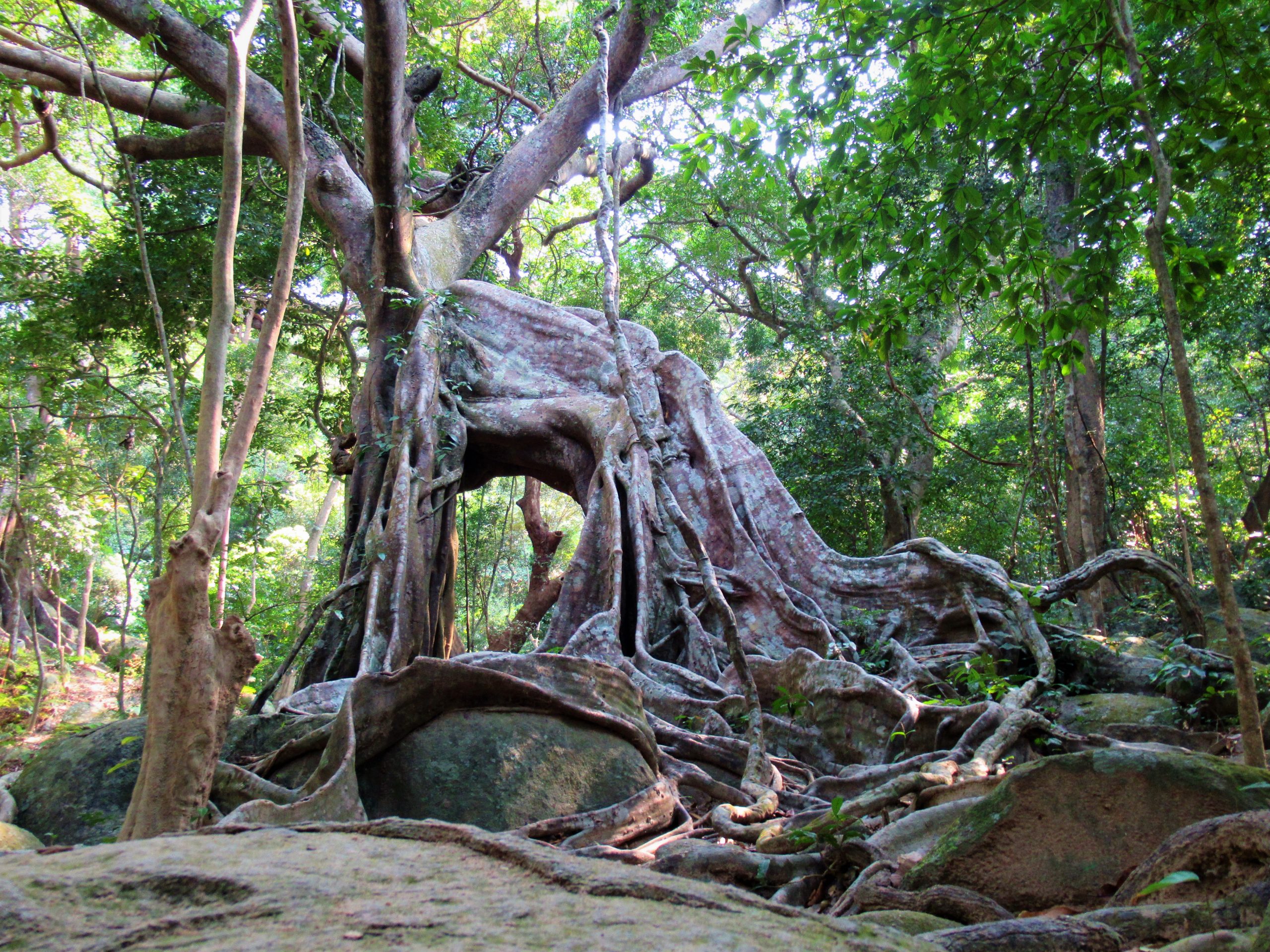
As a natural assembly point for communities over thousands of years, famous meetings and historical events have taken place beneath banyans. One such example is the great banyan of Tan Trao in Tuyen Quang Province, northern Vietnam which, on 16 August, 1945, witnessed the proclamation by General Giáp of the Viet Minh uprising to wrest control from the colonial French and occupying Japanese forces in what became known as the August Revolution, leading to Ho Chi Minh’s Declaration of Independence in Hanoi on 2 September, just two weeks later. This event, started beneath a banyan tree, is commemorated in every Vietnamese city today with the road name ‘Cách Mạng Tháng Tám’ (August Revolution). The banyan tree under which this revolution began is still standing in Tuyen Quang Province today. Hence, that tree is now regarded by many Vietnamese as a symbol of revolution, liberation, independence and freedom, of Vietnam’s fighting spirit, military prowess and national strength. People make pilgrimages to the tree from all corners of the nation.
*Historical information in this article is based only on my limited reading & understanding of various sources & conversations with people: I am not an historian & I cannot vouch for the accuracy of historical details on this page.

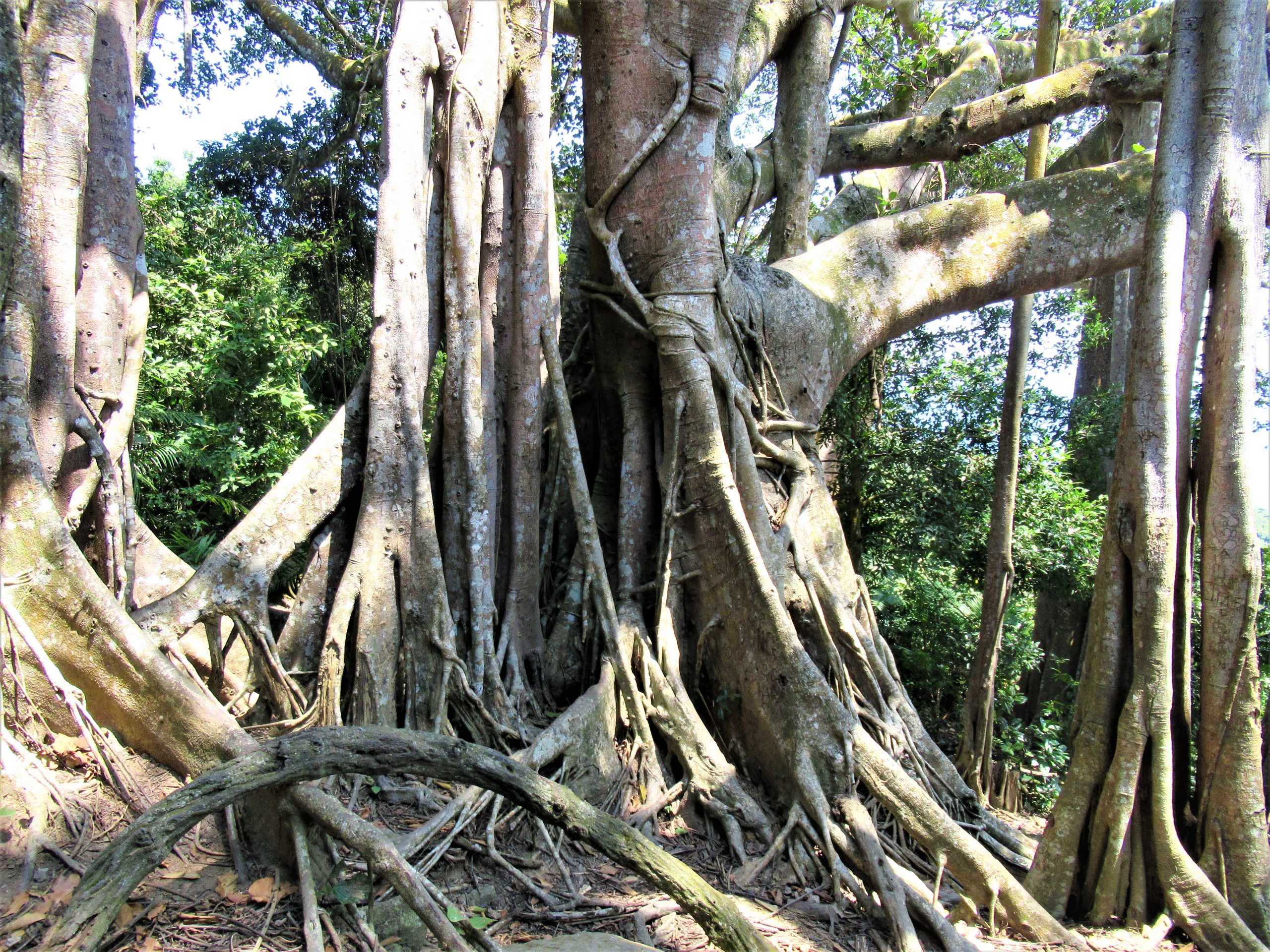
Environmental Change & Destruction:
Vietnam is one of several countries where great, ancient banyans grow. Sadly, their numbers have declined dramatically over the last 50 years. Such is the growth time-scale of banyans it’s doubtful if their numbers will ever recover. The wars of the 20th century, which saw American carpet-bombing of vast swathes of densely forested land with the express purpose of flaying the jungles so as to rob the enemy of their cover, caused massive destruction of centuries-old banyans. But, even more devastating has been the post-war years, particularly since the economic reforms of 1986 and the subsequent rapid industrialization of Vietnam. Old-growth forests have been decimated for the harvesting of valuable hardwood trees which fetch high prices in a multi-billion dollar industry, including expensive wooden furniture sold around the world. Forest clearance for mass cultivation of cash crops, particularly coffee, has seen banyans felled across the nation, so too has the construction of hundreds of hydropower plants on remote rivers and mining for bauxite and other minerals deep in the forests. All this is good for the economy and has played a massive role in raising the nation’s GDP, per capita income and general living standards over the last 30 years, but bad for banyans and the environment in general. The banyans that survive are either deep in the jungles, away from agriculture and industry, or have been preserved for their cultural or spiritual significance.

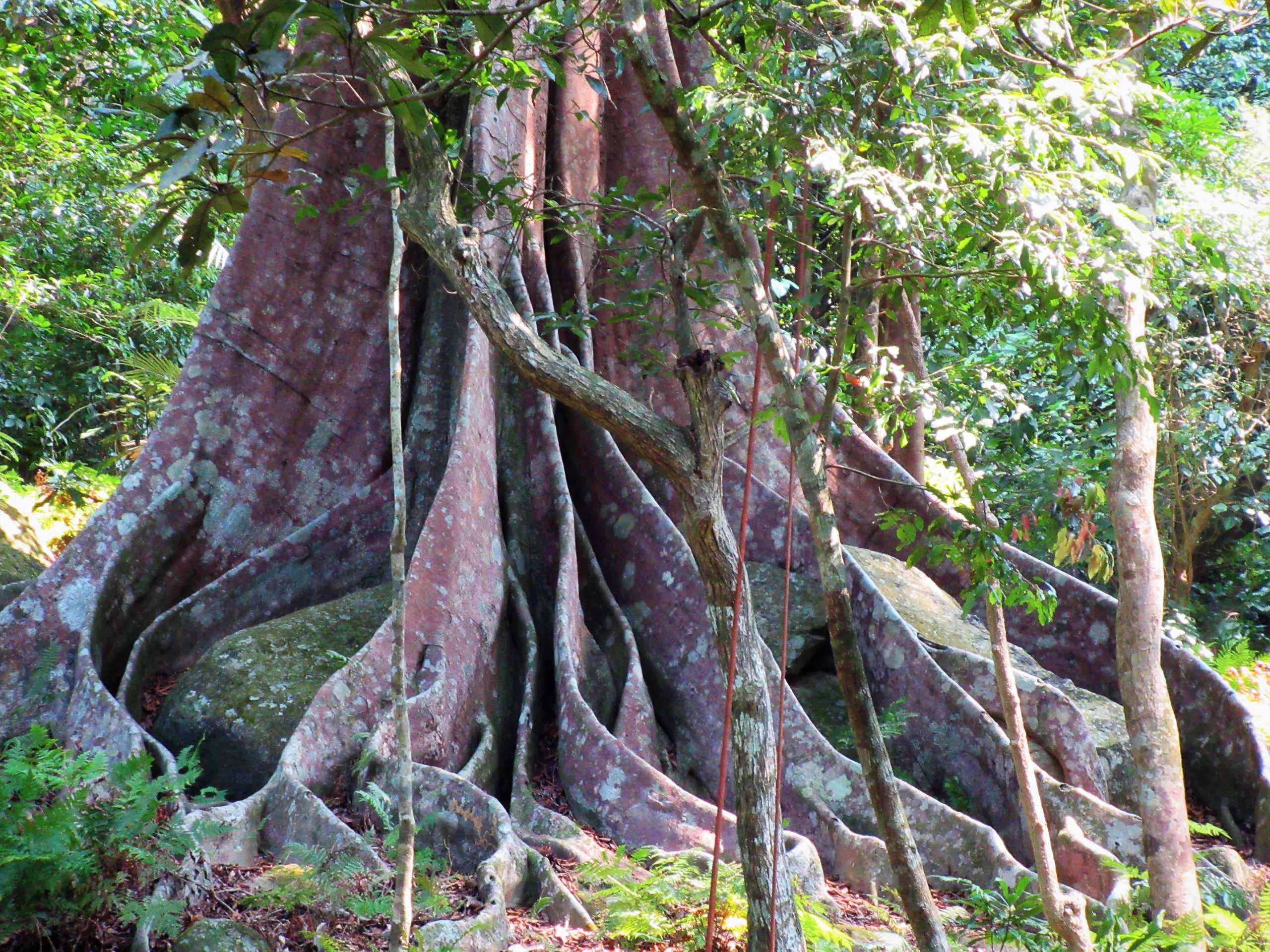
The banyan may well be thought of by future generations in the way that we think of large extinct animals today: with awe and disbelief that something so big, majestic and beautiful once stood on the face of the same planet as we inhabit. I can imagine, in the not too distant future, people staring at photographs of great old banyans, trying to conceive of a time when these gigantic trees actually grew – slowly and silently – in the forests, rather than being museum exhibits and historical relics. I once saw a banyan tree cut down in Vietnam (in this case for safety reasons): it was sad to witness something so strong and long-lived – something whose roots and trunks and branches had grown steadily over hundreds of years to secure its stability and survival – be destroyed in a matter of hours by modern machinery.

*Disclosure: I never receive payment for anything I write: all my content is free & independent. I’ve written this article because I want to: I like banyan trees & I want my readers to know about them. For more details, see my Disclosure & Disclaimer statements.

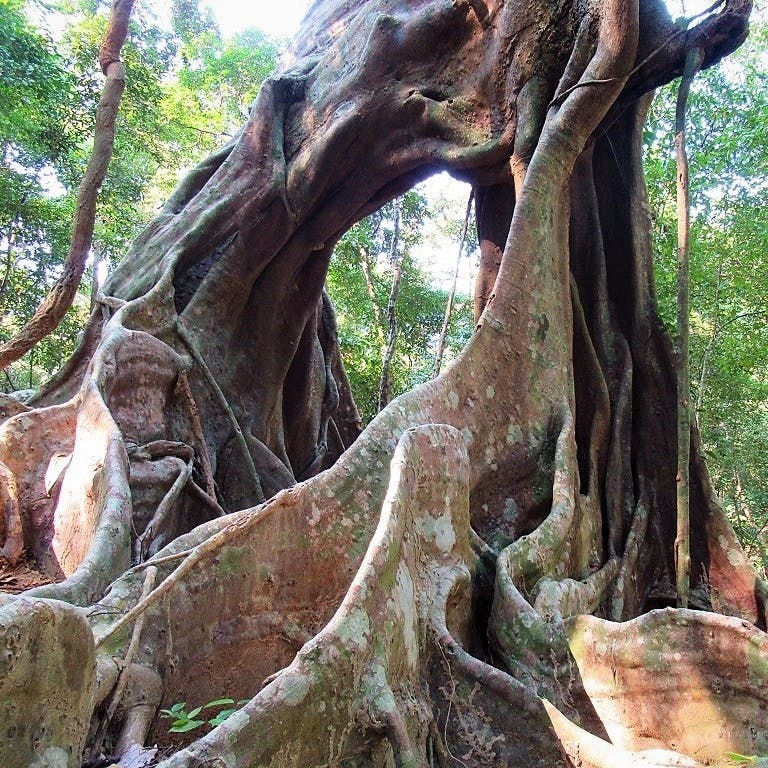
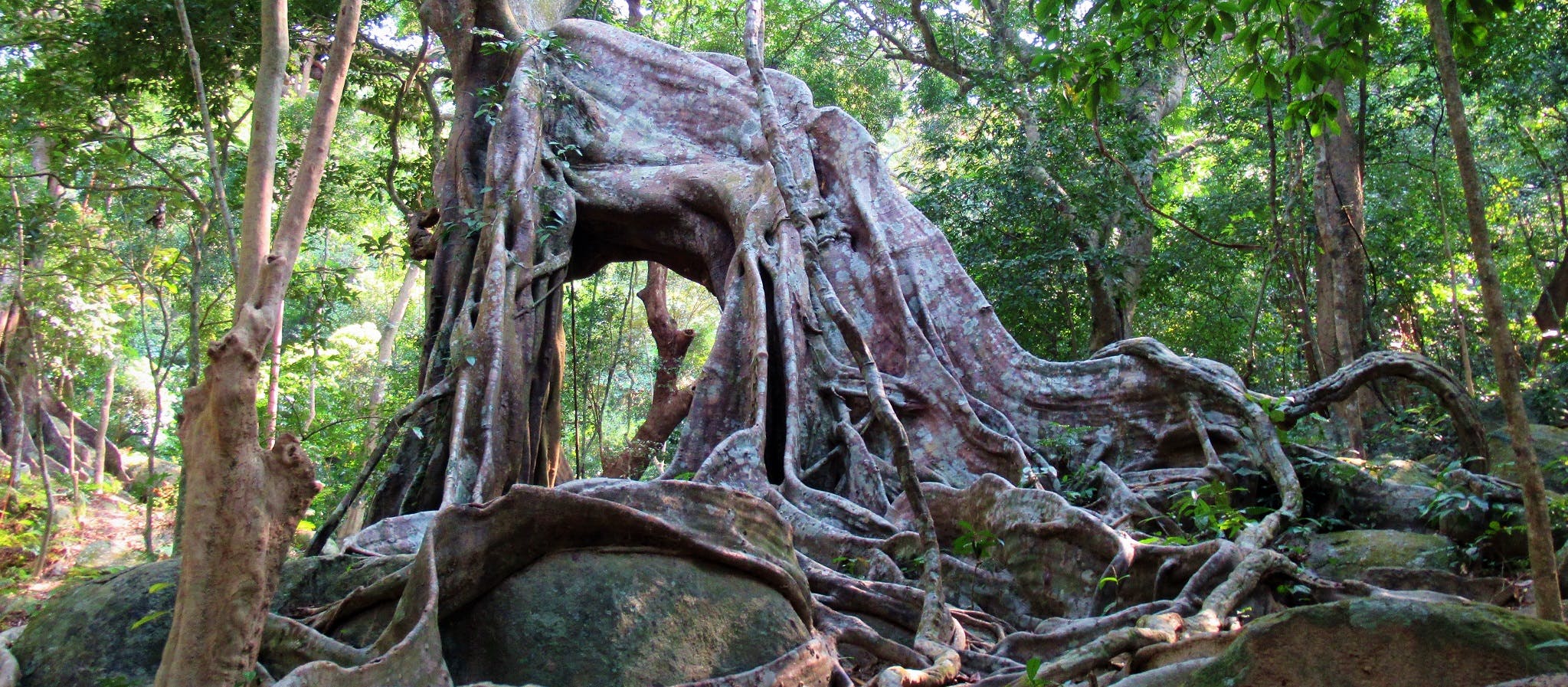

The Cây Đa Ngàn Năm & Cây đa con Nai at the tip of the Son Tra peninsula, near Danang, is unfortunately not accessible at the moment due to a landslide; I tried it a week ago.
Thanks, Matt. I’m sure they’ll get that cleared up soon enough.
Best,
Tom
Hi,
Thank you so much for your article about the banyan trees. I’m planning a trip to Vietnam (Saigon, Mekong delta, Danang, Hoi An). I wonder if there are any locations (where I could admire an old banyan tree) you could recommend me? Thanks!
Best regards,
Marie-Anne
Hi Marie-Anne,
There are banyan trees throughout Vietnam. If you’re going to Danang, you could visit the ancient banyans at the tip of the Son Tra Peninsula.
Best,
Tom
Years ago a small group at a church I belonged to at the time sponsored a “boat family.” Tu, Phep, Liet and Tuyet Nguyen. I was in charge of this adventure with another member of our Sunday school class. Have been reading and thinking about Vietnam since. I am grateful that I found your website. So far I have read your Odes to the monsoon and the banyan tree. Thank you for your site and your description, passion about Vietnam.
Hi Barbara,
Thank you for your kind words. I am very happy to hear you have enjoyed reading about the Banyan Tree and Monsoon. I help you find more interesting articles on the site that will bring back more memories of your experience with Tu, Phep, Liet and Tuyet.
Best,
Tom